Graters & Slicers
These devices are very convenient, and can often quickly do jobs
that are difficult or nearly impossible with knives and mortars.
On the other hand, there are jobs that knives and mortars do a lot
better - use the right tool for the job
More on Kitchen Gear.
Box Grater
When recipes tell you to grate something, this is the device they
usually picture you using - it has been a kitchen standard for centuries.
There are other sizes and shapes, but this is the standard, and large
enough to grate many sizes of cheeses and vegetables effectively. It
is always ready and very easy to clean.
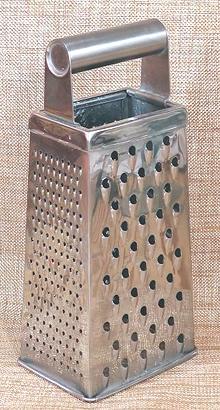
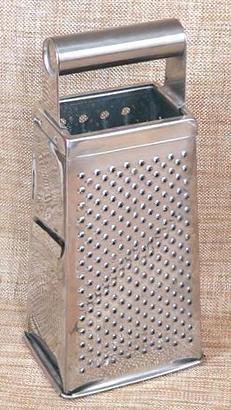 The photo specimen is a standard size, stainless Steel box grater, of
unknown brand. It has been in use in my kitchen for 40 years or more.
The cutting surfaces measures 4 x 2-7/8 inches at the base and 3-1/4 x
2-3/8 at the top. It is 9-1/2 inches tall, including the handle, with
cutting surfaces 6-1/2 inches long.
The photo specimen is a standard size, stainless Steel box grater, of
unknown brand. It has been in use in my kitchen for 40 years or more.
The cutting surfaces measures 4 x 2-7/8 inches at the base and 3-1/4 x
2-3/8 at the top. It is 9-1/2 inches tall, including the handle, with
cutting surfaces 6-1/2 inches long.
The first photo shows the Large Hole and Small Hole sides. These
cut things into medium strips and narrow threads. I probably use the
small holes side the most, particularly for hard cheeses and to harvest
lemon, lime, and orange zest. The big hole side I've used for soft
cheeses, apples and other softer items.
The second photo shows the Nail Hole and Slicer sides. The nail hole
side is particularly useful for grating ginger, onions, or other
vegetables when your intent is to wrap them in cloth and wring out the
juice for use in recipes. The slicer side is the most dangerous side,
and I'd never used it, until I tested if for writing this page. It
slices way thinner than I usually want things sliced, though I can
see it as very useful when preparing some garnishes.
Clearly, this device must be used with care, but it is nowhere near
as dangerous as a Mandolin (the slicer, not the musical instrument,
which is dangerous only to finger tips). Where the Mandolin can take
significant flesh, this device will only cause abrasions - except the
slicer side (see above) which can cut, but not nearly as deeply.
Nutmeg Grater
 If you have been using ground Nutmeg out of a spice jar, you have no
idea what Nutmeg tastes like. This grater lives in my spice drawer,
right beside the jar of Nutmegs. It takes only seconds to have real
nutmeg flavor.
If you have been using ground Nutmeg out of a spice jar, you have no
idea what Nutmeg tastes like. This grater lives in my spice drawer,
right beside the jar of Nutmegs. It takes only seconds to have real
nutmeg flavor.
Microplane®
 Unlike many graters, the Microplanes are very sharp, made from thin
but hard stainless steel. They are available in various sizes and
fineness. The one in the photo is a coarse and unusually large one. I got
it to see how it worked taking the brown backing off pieces of coconut.
It did a credible job of it, taking less strength but more time than
a very sharp vegetable peeler. It did clog now and then, but the clogs
were removed by a simple tap on the cutting board. It also does just fine
for zesting a lemon or lime, though they sell smaller, finer ones for
that. This one comes with a snap on plastic shield, to protect the
cutting edges, and prevent accidents.
Unlike many graters, the Microplanes are very sharp, made from thin
but hard stainless steel. They are available in various sizes and
fineness. The one in the photo is a coarse and unusually large one. I got
it to see how it worked taking the brown backing off pieces of coconut.
It did a credible job of it, taking less strength but more time than
a very sharp vegetable peeler. It did clog now and then, but the clogs
were removed by a simple tap on the cutting board. It also does just fine
for zesting a lemon or lime, though they sell smaller, finer ones for
that. This one comes with a snap on plastic shield, to protect the
cutting edges, and prevent accidents.
Drum Grater / Slicer
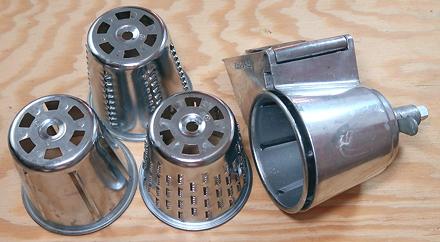 This grater / slicer set is made as an accessory to the KitchenAid
Stand Mixer, but such devices are also available as stand-alone
hand cranked tools. I have used this set for larger grating and
slicing jobs for about 40 years. The main disadvantage is that items
sliced in a drum come out curved.
This grater / slicer set is made as an accessory to the KitchenAid
Stand Mixer, but such devices are also available as stand-alone
hand cranked tools. I have used this set for larger grating and
slicing jobs for about 40 years. The main disadvantage is that items
sliced in a drum come out curved.
Grating & Slicing Disks
for Food Processor
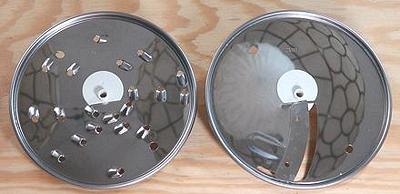
These are grating and slicing disks for a Food Processor. They stand
on a stem so they are just below the top, and stuff shoved down the feed
tube hits them immediately. They are available in various configurations,
fine to coarse and thick to thin. These two came with my big KitchenAid
Food Processor. I'm sure they work well, but I've never used them. I
don't have counter space for the food processor, so I only bring it out
when I really need it, and it's a heavy SOB. The appropriate
spot on my counter is taken up by a big KitchenAid Stand Mixer, and
that isn't going to change.
Mandolin
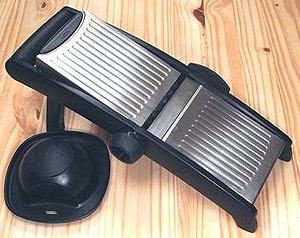 This is a very useful and time saving device when doing larger jobs.
Good ones can cut to any thicknesses up to 3/8 inch, do wavy cuts,
julienne, and cut potato fries. It is, however, a Dangerous
Device and should not be operated by children, teens, or adults
"under the influence". This important device has it's own
Mandolin page.
This is a very useful and time saving device when doing larger jobs.
Good ones can cut to any thicknesses up to 3/8 inch, do wavy cuts,
julienne, and cut potato fries. It is, however, a Dangerous
Device and should not be operated by children, teens, or adults
"under the influence". This important device has it's own
Mandolin page.
ke_grtsicz 201003 - www.clovegarden.com
©Andrew Grygus - agryg@clovegaden.com
Photos on this
page not otherwise credited are © cg1 -
Linking to and non-commercial use of this page permitted

 The photo specimen is a standard size, stainless Steel box grater, of
unknown brand. It has been in use in my kitchen for 40 years or more.
The cutting surfaces measures 4 x 2-7/8 inches at the base and 3-1/4 x
2-3/8 at the top. It is 9-1/2 inches tall, including the handle, with
cutting surfaces 6-1/2 inches long.
The photo specimen is a standard size, stainless Steel box grater, of
unknown brand. It has been in use in my kitchen for 40 years or more.
The cutting surfaces measures 4 x 2-7/8 inches at the base and 3-1/4 x
2-3/8 at the top. It is 9-1/2 inches tall, including the handle, with
cutting surfaces 6-1/2 inches long. If you have been using ground Nutmeg out of a spice jar, you have no
idea what Nutmeg tastes like. This grater lives in my spice drawer,
right beside the jar of Nutmegs. It takes only seconds to have real
nutmeg flavor.
If you have been using ground Nutmeg out of a spice jar, you have no
idea what Nutmeg tastes like. This grater lives in my spice drawer,
right beside the jar of Nutmegs. It takes only seconds to have real
nutmeg flavor.
 Unlike many graters, the Microplanes are very sharp, made from thin
but hard stainless steel. They are available in various sizes and
fineness. The one in the photo is a coarse and unusually large one. I got
it to see how it worked taking the brown backing off pieces of coconut.
It did a credible job of it, taking less strength but more time than
a very sharp vegetable peeler. It did clog now and then, but the clogs
were removed by a simple tap on the cutting board. It also does just fine
for zesting a lemon or lime, though they sell smaller, finer ones for
that. This one comes with a snap on plastic shield, to protect the
cutting edges, and prevent accidents.
Unlike many graters, the Microplanes are very sharp, made from thin
but hard stainless steel. They are available in various sizes and
fineness. The one in the photo is a coarse and unusually large one. I got
it to see how it worked taking the brown backing off pieces of coconut.
It did a credible job of it, taking less strength but more time than
a very sharp vegetable peeler. It did clog now and then, but the clogs
were removed by a simple tap on the cutting board. It also does just fine
for zesting a lemon or lime, though they sell smaller, finer ones for
that. This one comes with a snap on plastic shield, to protect the
cutting edges, and prevent accidents.
 This grater / slicer set is made as an accessory to the KitchenAid
Stand Mixer, but such devices are also available as stand-alone
hand cranked tools. I have used this set for larger grating and
slicing jobs for about 40 years. The main disadvantage is that items
sliced in a drum come out curved.
This grater / slicer set is made as an accessory to the KitchenAid
Stand Mixer, but such devices are also available as stand-alone
hand cranked tools. I have used this set for larger grating and
slicing jobs for about 40 years. The main disadvantage is that items
sliced in a drum come out curved.

 This is a very useful and time saving device when doing larger jobs.
Good ones can cut to any thicknesses up to 3/8 inch, do wavy cuts,
julienne, and cut potato fries. It is, however, a Dangerous
Device and should not be operated by children, teens, or adults
"under the influence". This important device has it's own
Mandolin page.
This is a very useful and time saving device when doing larger jobs.
Good ones can cut to any thicknesses up to 3/8 inch, do wavy cuts,
julienne, and cut potato fries. It is, however, a Dangerous
Device and should not be operated by children, teens, or adults
"under the influence". This important device has it's own
Mandolin page.